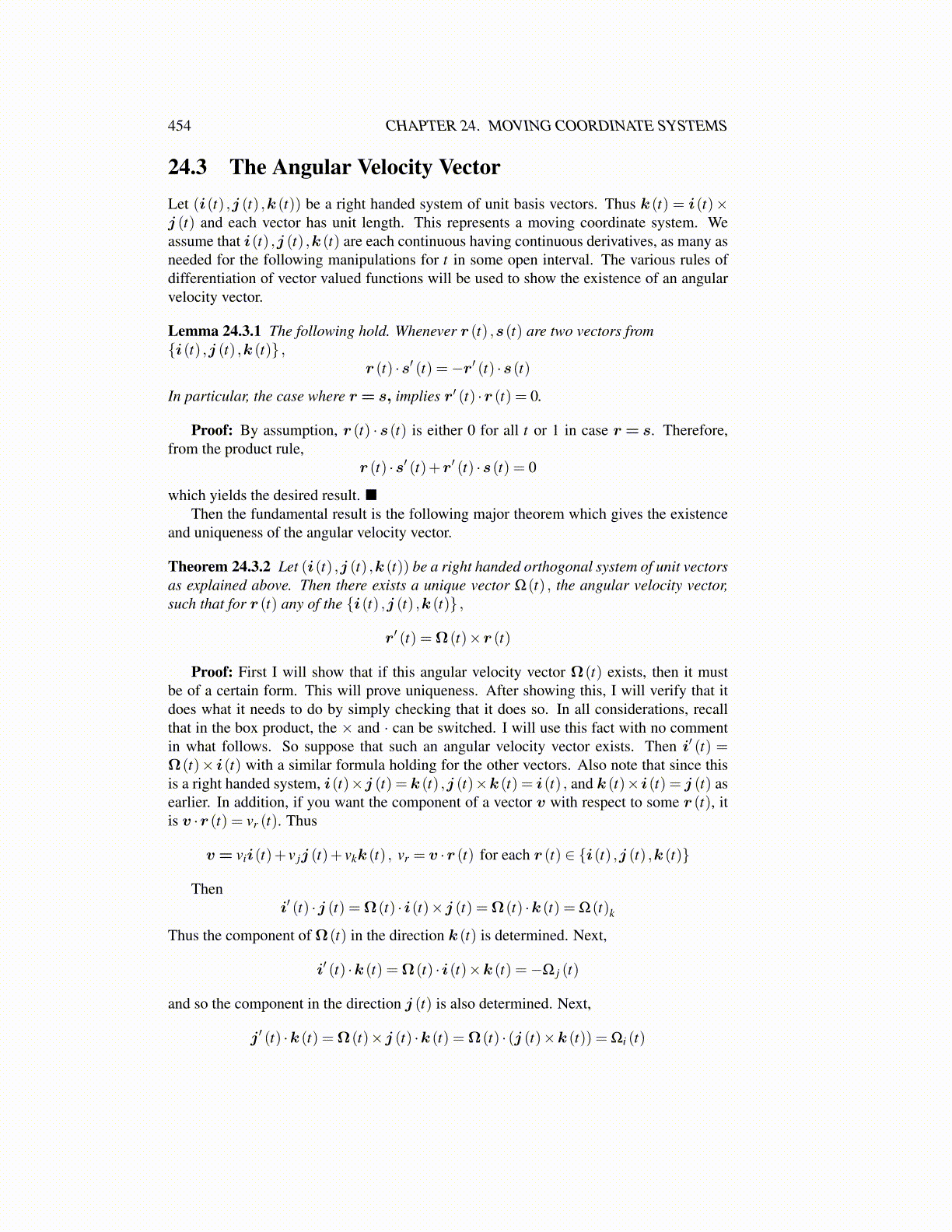
454 CHAPTER 24. MOVING COORDINATE SYSTEMS
24.3 The Angular Velocity VectorLet (i(t) ,j (t) ,k (t)) be a right handed system of unit basis vectors. Thus k (t) = i(t)×j (t) and each vector has unit length. This represents a moving coordinate system. Weassume that i(t) ,j (t) ,k (t) are each continuous having continuous derivatives, as many asneeded for the following manipulations for t in some open interval. The various rules ofdifferentiation of vector valued functions will be used to show the existence of an angularvelocity vector.
Lemma 24.3.1 The following hold. Whenever r (t) ,s(t) are two vectors from{i(t) ,j (t) ,k (t)} ,
r (t) ·s′ (t) =−r′ (t) ·s(t)
In particular, the case where r = s, implies r′ (t) ·r (t) = 0.
Proof: By assumption, r (t) · s(t) is either 0 for all t or 1 in case r = s. Therefore,from the product rule,
r (t) ·s′ (t)+r′ (t) ·s(t) = 0
which yields the desired result. ■Then the fundamental result is the following major theorem which gives the existence
and uniqueness of the angular velocity vector.
Theorem 24.3.2 Let (i(t) ,j (t) ,k (t)) be a right handed orthogonal system of unit vectorsas explained above. Then there exists a unique vector Ω(t) , the angular velocity vector,such that for r (t) any of the {i(t) ,j (t) ,k (t)} ,
r′ (t) =Ω(t)×r (t)
Proof: First I will show that if this angular velocity vector Ω(t) exists, then it mustbe of a certain form. This will prove uniqueness. After showing this, I will verify that itdoes what it needs to do by simply checking that it does so. In all considerations, recallthat in the box product, the × and · can be switched. I will use this fact with no commentin what follows. So suppose that such an angular velocity vector exists. Then i′ (t) =Ω(t)× i(t) with a similar formula holding for the other vectors. Also note that since thisis a right handed system, i(t)×j (t) = k (t) ,j (t)×k (t) = i(t) , and k (t)× i(t) = j (t) asearlier. In addition, if you want the component of a vector v with respect to some r (t), itis v ·r (t) = vr (t). Thus
v = vii(t)+ v jj (t)+ vkk (t) , vr = v ·r (t) for each r (t) ∈ {i(t) ,j (t) ,k (t)}
Theni′ (t) ·j (t) =Ω(t) · i(t)×j (t) =Ω(t) ·k (t) = Ω(t)k
Thus the component of Ω(t) in the direction k (t) is determined. Next,
i′ (t) ·k (t) =Ω(t) · i(t)×k (t) =−Ω j (t)
and so the component in the direction j (t) is also determined. Next,
j ′ (t) ·k (t) =Ω(t)×j (t) ·k (t) =Ω(t) · (j (t)×k (t)) = Ωi (t)